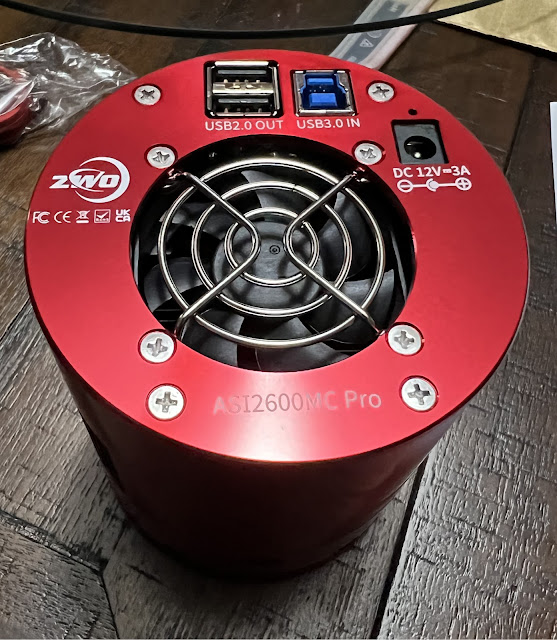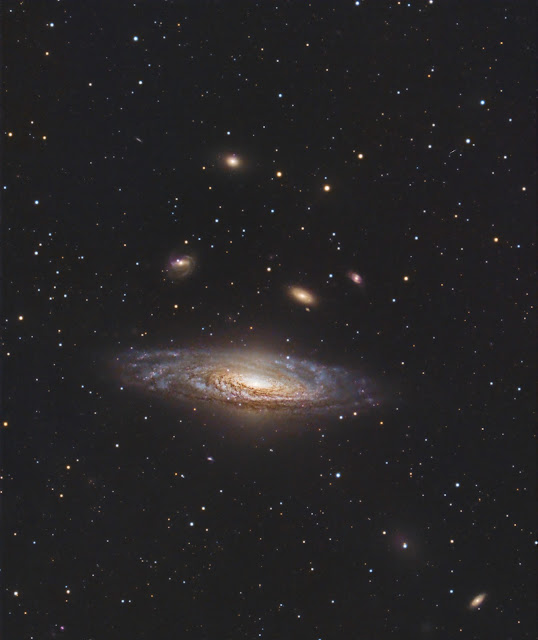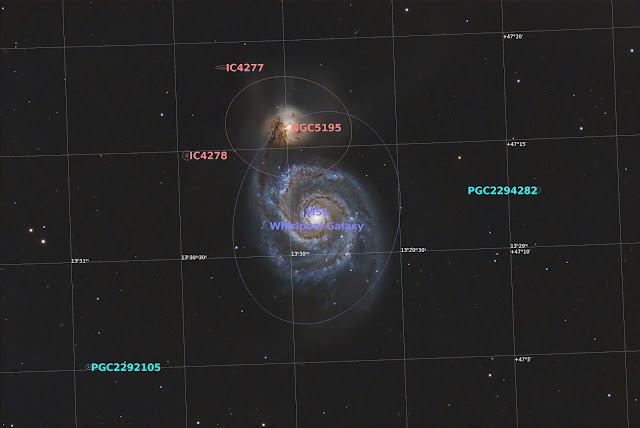Chasing Comet C/2023 A3 (Tsuchinshan-ATLAS)
Saturday 10/12/2024 - Lakeview, NY
Chasing comets is so much fun. My first experience trying to capture one photographically was Comet Neowise in July of 2020. I was pretty new to astrophotography, so my results were ok, but it was so much fun. Was waiting for a chance for a bright comet now that my skills have improved. The Astronomy community has been excited for Comet C/2023 A (Tsuchinshan-ATLAS) almost as soon as it was discovered. Even though predictions for this comet indicated it could be a good one, we all take them with a grain of salt. Comets are like cats; they both have tails and they do what they want.
Saturday 10/12 would be the first chance for me to catch the comet in the evening sky, as the comet had traveled around the Sun and became an evening object on Friday 10/11. The weather was poor on Friday, but Saturday was clear all day with clouds coming in at twilight. Would the clouds stay away long enough to get a peak at the comet? Next problem, where to observe? I have a fairly decent western horizon if I go to the farm across the street from my house. Looking at planetarium apps, it was close. My son-in-law's parents have a home on Lake Erie. In fact, their backyard is on a cliff above Lake Erie. They were gracious and allowed me to set up my DSLR and tripod in their yard. I also had my binoculars and my son-in-law's father also had a pair of binoculars. We were treated to a beautiful sunset, but there was a heavy bank of clouds on the horizon. I was afraid the comet would be behind the clouds.
Spoiler alert, my expectation of where the comet would be, specifically how high above the horizon, was significantly off. My expectation of when the comet would be visible was off as well. Their neighbor came outside and asked if we could see anything. We told him we couldn't see anything, so he went back inside to attend to his parental duties. Just as was about to give up, we noticed Venus. It was much higher and further South than I expected. Arcturus became visible as well. The comet was roughly between Venus and Arcturus in azimuth, and it was close to Venus' altitude. We renewed the search, and their neighbor returned. We took turns looking through the binoculars. I kept snapping photos with my camera in hopes the comet would appear to the camera sensor before our eyes could detect it. Lots of false alarms, wispy clouds, jet contrails, but no comet. My son-in-law's mother told us she was seeing something and to her it felt like the comet. We thought it was another airplane contrail. She was pretty adamant; I pointed the camera based on her description relative to the clouds near the horizon. Took a photo at 7:33 pm, there it was!!!
We took turns looking through the binoculars and I kept taking pictures. The comet got brighter, and you could make it out naked eye. We watched it go behind clouds, then reemerge. We lost it to the dense cloud bank on the horizon around 8:07 PM. I was shooting with my Ha modified Canon T6i, fixed tripod, Canon 50 mm lens (The Nifty Fifty), and an intervalometer (used as a shutter release). I was taking pictures at different settings, bracketing exposures, to ensure I captured the comet.
Here's my best shot of the evening:
 |
Saturday 10/12/204 from Lake View, NY at 7:53 PM. 2.5 sec exposure at f/2.8 and ISO 1600. Processed in Adobe Lightroom Classic and NoiseXTerminator in PixInsight.
Monday 10/14/2024 - Eden, NYIt was very cloudy on Monday 10/14 so there was no expectation of seeing the comet. I had to pick up something from the grocery store and noticed significant breaks in the clouds, especially to the west. After returning home, I ran across the street and snapped a photo with my iPhone. Could definitely make out the comet. Went back home and grabbed the tripod with the iPhone adapter and set up to see if i capture the comet despite the clouds. The comet was visible to the naked eye, and I moved around to try and capture a pleasing composition. Here's my favorite shot from that evening. Cool note: The Planetary Society reposted my photo on their Instagram! |
 |
| Monday 10/14/2024 from Eden, NY at 7:57 PM. iPhone on a tripod. |
Wednesday 10/16/2024 - Eden, NY
Similar to Monday, patchy clouds and a bright Moon impacting the images and the visual observation. Set up across the street but in a slightly different location. Here are a couple of iPhone shots.
 |
| Wednesday 10/16/2024 from Eden, NY at 7:46 PM. iPhone on a tripod. |
 |
| Wednesday 10/16/2024 from Eden, NY at 7:46 PM. iPhone on a tripod at 3X Zoom. |
Thursday 10/17/2024 - Eden, NY
The skies were clear on Thursday night, but the transparency was not good. The Moon was full and definitely had an impact once it rose above the trees. I had difficulty seeing the comet naked eye, no trouble with binoculars (10x50). I had two imaging set ups going. The first set up was my Ha Modified Canon T6i with Canon 50 mm lens on the iOptron Sky Guider Pro. The other setup was an iPhone on a tripod.
 |
| Thursday 10/17/2024 from Eden, NY at 8:35 pm. Ha modified Canon T6i, iOptron Sky Guider Pro, Canon 50 mm lens (Nifty Fifty), and an intervalometer. 5 sec exposure, f/2.8 at ISO 800. Edited in adobe Lightroom classic, Photoshop, and PixInsight. |
 |
| Thursday 10/17/2024 from Eden, NY at 8:23 pm. iPhone on a Tripod. Edited in Photoshop. |
Friday 10/18/2024 - Eden, NY
No photos (yet) from Friday night.
Our observatory director came over to my house to observe/image the comet. I had the same set up as Thursday night. Conditions were better. Comet was more visible with the naked eye. The nearly Full Moon definitely impacted views and imaging.
Saturday 10/19/2024 - North Java, NY
Our local astronomy club, the Buffalo Astronomical Association (BAA), has our dark sky observatory on the grounds of the Buffalo Audubon Society's (BAS) Beaver Meadow Nature Center. We call our observatory the Beaver Meadow Observatory (BMO). The BAS asked us to open the observatory on 10/19 to support their Trick-or-Treat Hike event. We had several members show up with their scopes and we had the Celestron 14" Edge HD with the club's camera. We put my ZWO ASI2600MC pro on the club's Tele Vue NP101is (w/0.8 reducer). Both scopes ride on the Astro Physics AP1200 mount. Another member of our club's imaging subgroup put his dedicated astronomy camera on his 85 mm lens. We mounted this onto the NP101/14" Edge setup.
The event was from 4 pm to 9 pm so we shared views of the Sun early in the event and then switched to Comet, Saturn, and other Deep Sky Objects. We also have a member (he's one of the hosts of the 7th Magnitude podcast) that gives star/constellation tours with a laser pointer. This was a family-oriented event. Lots of families, with kids (and adults) dressed up in great Halloween costumes. The Comet was the ... STAR ... of the evening. We helped visitors find the comet and helped a few that brought their own camera set ups. People were able to find the comet using their phones, but some were able to see it naked eye (just barely). We had computer monitors and TV screens in the observatory control room displaying the images we were capturing of the comet. This worked out great, as large groups were able to cycle into the control to get a view and ask questions. One of our members did not bring her scope with her so she used my 8' Dob to share views of Saturn. Saturn's rings are almost edge on. It was a great night and the weather was perfect!
I was able to process the data from the NP101 with my camera (see image below). Still working on the data from the 14" Edge HD. I tagged Tele Vue when posting the image of the comet with the NP101 and my camera on social media. They reposted my post on X (formerly Twitter). That really made my day!!
 |
| Saturday 10/19 from the BMO. This is a picture of the monitor connected to the NP101is with my camera. This is a single exposure with NINA's unlinked screen stretch applied. |
 |
| Saturday 10/19/2024 from the BMO at 7:41 PM. Handheld iPhone shot from outside the observatory. |
 |
| Saturday 10/19/2024 from the BMO at 8:02 PM. Handheld iPhone shot from inside the observatory (from behind the telescopes). The NP101is is the smaller telescope mounted on top of the 14" EdgeHD. |
 |
| Saturday 10/19/2024 from the BMO at 9;04 PM. Handheld iPhone shot from outside the observatory. look carefully at the sky, note the Big Dipper skimming the trees. |
 |
| Saturday 10/19/2024 from the BMO. Tele Vue NP101is telescope w/0.8x Reducer, my ZWO ASI2600MC Pro, and Astro Physics AP1200 mount. 112 exposures at 15 sec each, -10 degrees C, gain 100, & Offset 50. Processed in PixInsight. |
 |
I tagged Tele Vue when sharing the image of the Comet on social media. They reposted my post to X (formerly Twitter). How cool is that!!!!
|
Saturday 10/26/2024 - Eden, NY
The forecast called for skies to clear around 8pm on Saturday 10/26. We had family over for dinner. I snuck out around 7 pm and set up my Ha Modified Canon T6i on the iOptron Sky guider pro. I also had the tripod with iPhone adapter. I captured images with DSLR using both the Canon 50 mm lens (Nifty Fifty) and the Rokinon 14" mm Lens. The comet was near the Milky Way core. I'm not really pleased with how the DSLR shots turned out. Here's an iPhone shot processed in Snapseed.
 |
Saturday 10/26/2024 from Eden, NY 8:14 PM. iPhone on a tripod. Processed in Snapseed on my iPhone.
So that's probably it for now ...The comet is getting dimmer and there are other targets I'll want to capture with the limited clear skies we get. Now that it gets darker earlier, we might go after the comet at the observatory at the beginning of an imaging session. We'll see. Chasing this comet was so much fun!! So many great experiences! Can't wat for the next one. |
Clear Skies!
Ernie













































